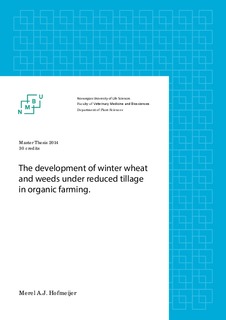| dc.contributor.advisor | Breland, Tor Arvid | |
| dc.contributor.advisor | Peigné, Josephine | |
| dc.contributor.advisor | Berner, Alfred | |
| dc.contributor.author | Hofmeijer, Merel Adriana Johanna | |
| dc.date.copyright | 2014 | |
| dc.date.issued | 2014 | |
| dc.identifier.uri | http://hdl.handle.net/11250/220861 | |
| dc.description | This document was written by an ISARA student in the framework of a convention with FiBL. For all citing, communication or distribution related to this document, ISARA has to be mentioned. | |
| dc.description.abstract | No-tillage and reduced tillage are soil conservation techniques directed to reduce soil erosion and to enhance soil fertility. These techniques are adopted into conventional agriculture where weeds are controlled with herbicides. To integrate reduced tillage into organic production, different strategies like adjusted mechanical weeding techniques and crop rotations have to be developed as the biggest challenge is weed control. The question arises if the new crop-weed interaction increases the competition resulting in yield losses. In the long-term organic tillage experiment in Frick with tillage and fertilisation as factors, the development of wheat and weed biomass and cover, as well as the proportion of mono- and dicotyledonous weed species were assessed. Wheat growth was additionally documented in chlorophyll content of the flag leaf (SPAD) and the length of the plants. Light competition was measured within the crop (LUX) at different levels. The monitoring was done at 4 different wheat growth stages before and after tillering, at flowering and just before harvest. The harvest data are not included in this report. To assess the weed competition on wheat growth more in depth, subplots were established in addition with one subplot being manually cleaned from weeds and the other being left weed infested. The wheat crop had a better start into the season in the reduced tillage plots. Wheat biomass was ca. 30 % higher than in the ploughed plots and a ca. 5 % higher chlorophyll content indicate a better nutrient supply. Wheat length was thus higher throughout the season. The grass-clover ley destruction in the preceding autumn together with the higher organic matter content in the reduced tilled soil must have induced a higher mineralisation of nitrogen during the relatively mild winter. Also weeds did profit and were at all times more present in the reduced tillage treatment with a maximum of 109.3 g m-2 in biomass and 8.4 % in cover. However, the competition assessment between cleaned and infested subplots showed that this increased weed infestation still didn’t affect wheat growth. In addition to grass species already observed in the years before, the species of the grass-clover ley were regrown in the reduced but not in the ploughed plots. The clover was suppressed by the crop. Grass species profited of the fertilisation with slurry with a growth response correlated to the amount of slurry applied. It has to be seen whether the nutrient supply in spring and the weed presence differing between tillage treatments will affect yields in the end. | nb_NO |
| dc.language.iso | eng | nb_NO |
| dc.publisher | Norwegian University of Life Sciences, Ås | |
| dc.rights.uri | http://creativecommons.org/licenses/by-nc/3.0/no/ | * |
| dc.subject | Reduced tillage | nb_NO |
| dc.subject | Weed competition | nb_NO |
| dc.subject | Winter wheat | nb_NO |
| dc.title | Development of winter wheat and weeds in organic reduced tillage | nb_NO |
| dc.type | Master thesis | nb_NO |
| dc.subject.nsi | VDP::Agriculture and fishery disciplines: 900::Agriculture disciplines: 910::Soil sciences: 913 | nb_NO |
| dc.subject.nsi | VDP::Agriculture and fishery disciplines: 900::Agriculture disciplines: 910::Plant breeding, horticulture, plant protection, plant pathology: 911 | nb_NO |
| dc.source.pagenumber | 38 | nb_NO |
| dc.description.localcode | M-PV | nb_NO |

